MITSUBISHI MIRAGE G4 2019 Owner's Manual (in English)
Manufacturer: MITSUBISHI, Model Year: 2019, Model line: MIRAGE G4, Model: MITSUBISHI MIRAGE G4 2019Pages: 267, PDF Size: 38.31 MB
Page 221 of 267

Brake fluid 9-10 Vehicle care and maintenance
9
Check the washer fluid
level at regular inter-
vals and add washer fluid to reservoir if nec-essary. Open the reservoir cap and check the level of washer fluid.Full level is approximately 2 inches (5 cm) below from the upper surface of the reservoir. When freezing weather is anticipated, flush out the water in the reservoir by operating the pump. Fill the reservoir with windshield anti-freeze (not radiator an
tifreeze), and operate
the system for a few seconds to flush out the residual water.
N00938701314
The fluid level must be between the “MAX”and “MIN” marks on the reservoir. The fluid level falls slightly with wear of the brake pads, but this
does not indicate any
abnormality. The fluid in the master cylinder should be checked when doing other work under theengine hood. The brake system should also be checked for leaks at the same time. If the fluid level falls
noticeably in a short
length of time, it indi
cates leaks from the
brake system.
If this occurs, have the vehicle checked by an authorized Mitsubishi Motors dealer or arepair facility of your choice. Use the brake fluid conforming to DOT 3 or DOT 4. The reservoir cap must be tightly sealed to keep dirt and water out.
Upper surface Full
Brake fluid To check the fluid level
MAX MIN
Fluid type
WA R N I N G Take care in handling brake fluid as it is harmful to the eyes, may irritates your skin and will damage
painted surfaces.
Wipe up spills immediately. If brake fluid gets on your hands or in your eyes, flush immediately with cleanwater. Follow up with a doctor as neces- sary.CAUTION Do not let any petrol
eum-based fluid touch,
mix with, or get into
the brake fluid. This
will damage the seals. Be careful when handli
ng brake fluid. It can
damage painted surfaces. Use only the listed brake fluid. Different brands of brake fluid
have different addi-
tives, and these can cause a chemical reac- tion. Do not mix brands of brake fluid.
BK0267800US.book 10 ページ 2018年5月30日 水曜日 午後4時24分
Page 222 of 267
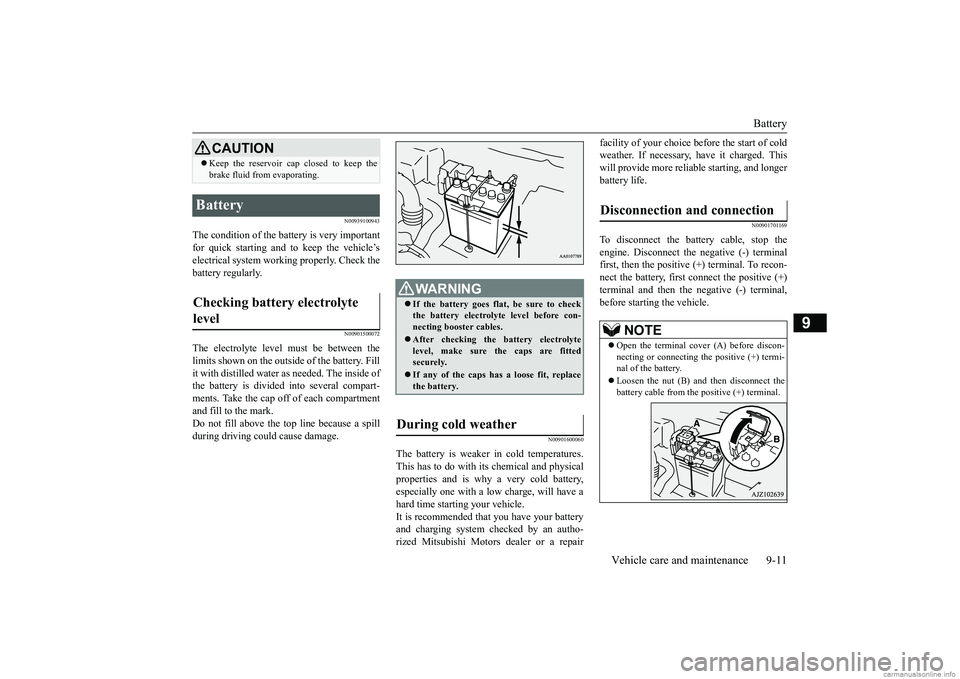
Battery
Vehicle care and maintenance 9-11
9
N00939100943
The condition of the batte
ry is very important
for quick starting and to keep the vehicle’s electrical system working properly. Check thebattery regularly.
N00901500072
The electrolyte level
must be between the
limits shown on the outside of the battery. Fill it with distilled water as needed. The inside ofthe battery is divided into several compart- ments. Take the cap off of each compartment and fill to the mark.Do not fill above the top line because a spill during driving could cause damage.
N00901600060
The battery is weaker in cold temperatures. This has to do with its chemical and physical properties and is why a very cold battery, especially one with a lo
w charge, will have a
hard time starting your vehicle. It is recommended that you have your battery and charging system checked by an autho-rized Mitsubishi Motors dealer or a repair
facility of your choice
before the start of cold
weather. If necessary, have it charged. Thiswill provide more reliab
le starting, and longer
battery life.
N00901701169
To disconnect the battery cable, stop theengine. Disconne
ct the negative (-) terminal
first, then the positive
(+) terminal. To recon-
nect the battery, first
connect the positive (+)
terminal and then the negative (-) terminal,before starting the vehicle.
Keep the reservoir cap closed to keep the brake fluid from evaporating.
Battery Checking battery electrolyte level
CAUTION
WA R N I N G If the battery goes flat, be sure to check the battery electrolyte level before con-necting booster cables. After checking the battery electrolyte level, make sure the caps are fitted securely. If any of the caps has a loose fit, replace the battery.
During cold weather
Disconnection and connection
NOTE
Open the terminal cover (A) before discon- necting or connecting the positive (+) termi- nal of the battery. Loosen the nut (B) and then disconnect the battery cable from the positive (+) terminal.
BK0267800US.book 11 ページ 2018年5月30日 水曜日 午後4時24分
Page 223 of 267
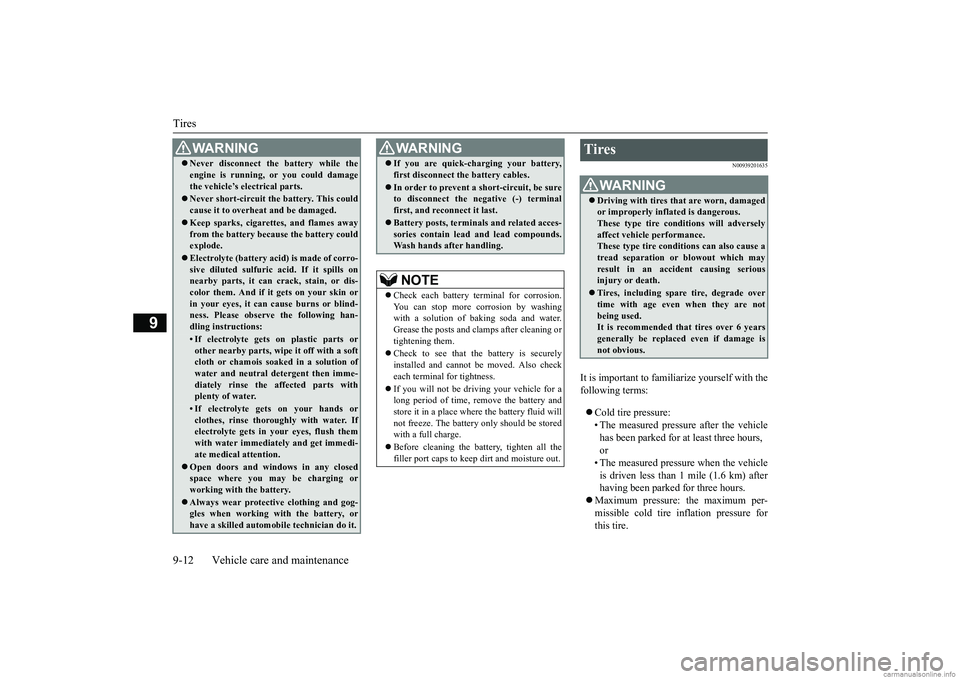
Tires 9-12 Vehicle care and maintenance
9
N00939201635
It is important to familiarize yourself with the following terms: Cold tire pressure: • The measured pressure after the vehicle has been parked for
at least three hours,
or• The measured pressure when the vehicle is driven less than 1 mile (1.6 km) after having been parked for three hours.
Maximum pressure: the maximum per- missible cold tire inflation pressure for this tire.
WA R N I N G Never disconnect the battery while the engine is running, or you could damagethe vehicle’s electrical parts. Never short-circuit the battery. This could cause it to overheat and be damaged. Keep sparks, cigarette
s, and flames away
from the battery because the battery couldexplode. Electrolyte (battery acid) is made of corro- sive diluted sulfuric acid. If it spills on nearby parts, it can crack, stain, or dis- color them. And if it gets on your skin orin your eyes, it can cause burns or blind- ness. Please observe the following han- dling instructions:• If electrolyte gets on plastic parts orother nearby parts, wipe it off with a softcloth or chamois soak
ed in a solution of
water and neutral detergent then imme- diately rinse the affected parts withplenty of water.• If electrolyte gets on your hands orclothes, rinse thoroughly with water. If electrolyte gets in
your eyes, flush them
with water immediately and get immedi-ate medical attention.
Open doors and wind
ows in any closed
space where you may be charging or working with the battery. Always wear protective clothing and gog- gles when working with the battery, or have a skilled automobi
le technician do it.
If you are quick-charging your battery, first disconnect the battery cables. In order to prevent a short-circuit, be sure to disconnect the negative (-) terminal first, and reconnect it last. Battery posts, termin
als and related acces-
sories contain lead
and lead compounds.
Wash hands after handling.NOTE
Check each battery terminal for corrosion. You can stop more corrosion by washing with a solution of baking soda and water. Grease the posts and cl
amps after cleaning or
tightening them. Check to see that the battery is securely installed and cannot be
moved. Also check
each terminal for tightness. If you will not be driv
ing your vehicle for a
long period of time, re
move the battery and
store it in a place where the battery fluid willnot freeze. The batter
y only should be stored
with a full charge. Before cleaning the ba
ttery, tighten all the
filler port caps to keep
dirt and moisture out.
WA R N I N G
Tires
WA R N I N GDriving with tires that are worn, damaged or improperly inflated is dangerous.These type tire conditions will adversely affect vehicle performance. These type tire conditions can also cause atread separation or blowout which may result in an accide
nt causing serious
injury or death. Tires, including spar
e tire, degrade over
time with age even when they are notbeing used. It is recommended that tires over 6 years generally be replaced even if damage isnot obvious.
BK0267800US.book 12 ページ 2018年5月30日 水曜日 午後4時24分
Page 224 of 267
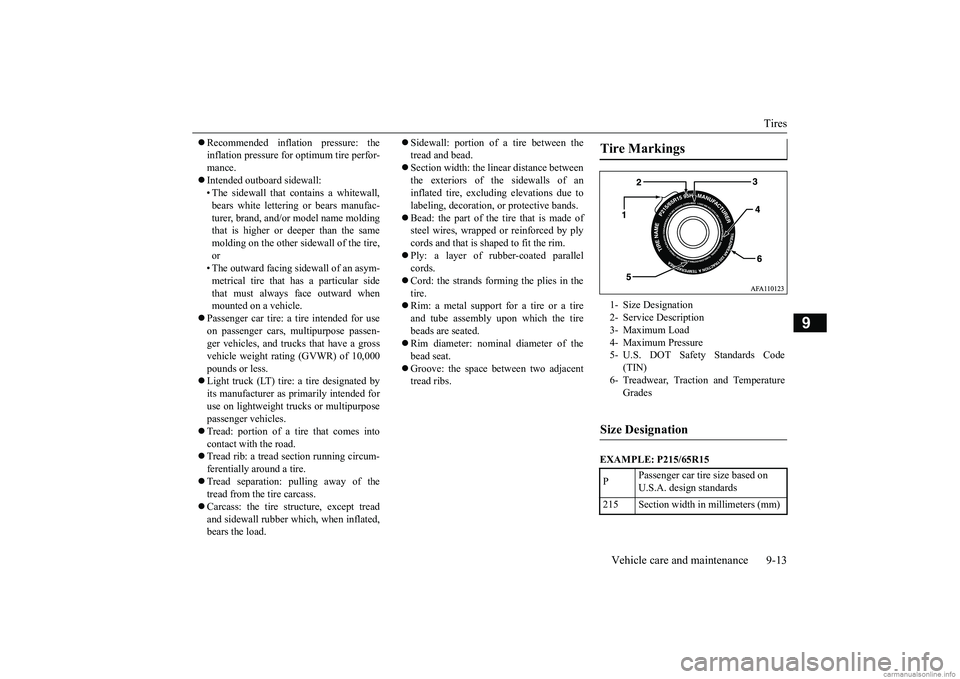
Tires
Vehicle care and maintenance 9-13
9
Recommended inflation pressure: the inflation pressure for optimum tire perfor-mance. Intended outboard sidewall: • The sidewall that c
ontains a whitewall,
bears white letteri
ng or bears manufac-
turer, brand, and/or model name molding that is higher or deeper than the samemolding on the other sidewall of the tire, or • The outward facing si
dewall of an asym-
metrical tire that has a particular side that must always face outward whenmounted on a vehicle.
Passenger car tire: a
tire intended for use
on passenger cars, multipurpose passen-ger vehicles, and trucks that have a gross vehicle weight rati
ng (GVWR) of 10,000
pounds or less. Light truck (LT) tire: a tire designated by its manufacturer as primarily intended for use on lightweight truc
ks or multipurpose
passenger vehicles. Tread: portion of a tire that comes into contact with the road. Tread rib: a tread se
ction running circum-
ferentially around a tire. Tread separation: pulling away of the tread from the tire carcass. Carcass: the tire structure, except tread and sidewall rubber which, when inflated,bears the load.
Sidewall: portion of a tire between the tread and bead. Section width: the line
ar distance between
the exteriors of the sidewalls of an inflated tire, excluding elevations due tolabeling, decoration, or protective bands. Bead: the part of the tire that is made of steel wires, wrapped
or reinforced by ply
cords and that is shaped to fit the rim. Ply: a layer of rubber-coated parallel cords. Cord: the strands forming the plies in the tire. Rim: a metal support for a tire or a tire and tube assembly upon which the tire beads are seated. Rim diameter: nominal diameter of the bead seat. Groove: the space between two adjacent tread ribs.
EXAMPLE: P215/65R15Tire Markings 1- Size Designation 2- Service Description 3- Maximum Load 4- Maximum Pressure5- U.S. DOT Safety Standards Code
(TIN)
6- Treadwear, Traction and Temperature
Grades
Size Designation P
Passenger car tir
e size based on
U.S.A. design standards
215 Section width in millimeters (mm)
BK0267800US.book 13 ページ 2018年5月30日 水曜日 午後4時24分
Page 225 of 267
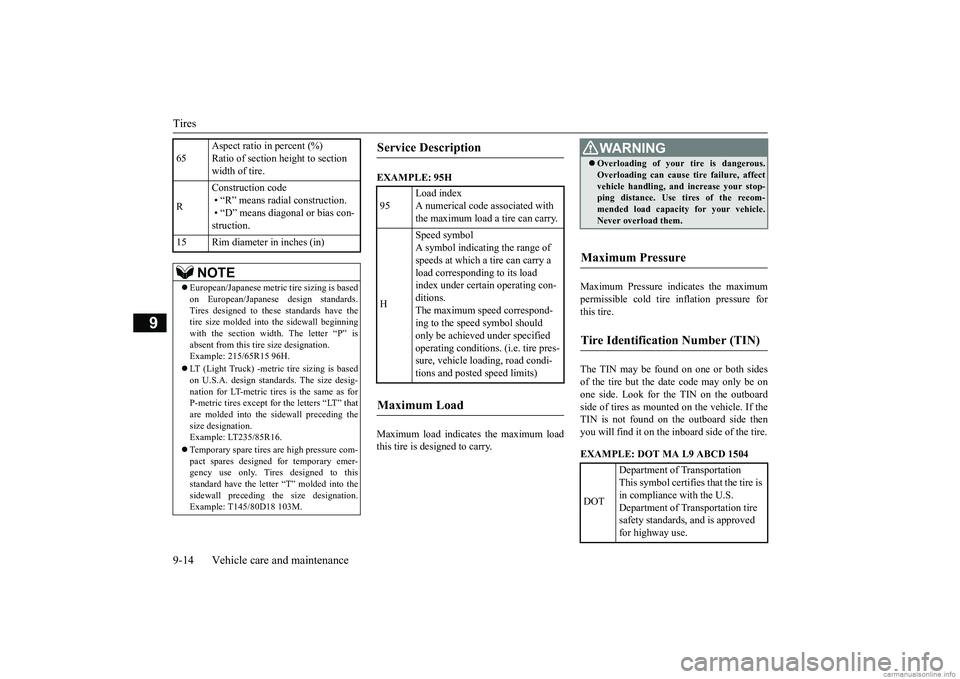
Tires 9-14 Vehicle care and maintenance
9
EXAMPLE: 95H Maximum load indicates the maximum load this tire is designed to carry.
Maximum Pressure i
ndicates the maximum
permissible cold tire inflation pressure for this tire. The TIN may be found on one or both sides of the tire but the date code may only be onone side. Look for the TIN on the outboard side of tires as mounted on the vehicle. If the TIN is not found on the outboard side thenyou will find it on the inboard side of the tire. EXAMPLE: DOT MA L9 ABCD 1504
65
Aspect ratio in percent (%) Ratio of section height to section width of tire.
R
Construction code • “R” means radial construction. • “D” means dia
gonal or bias con-
struction.
15 Rim diameter in inches (in)
NOTE
European/Japanese metric tire sizing is based on European/Japanese design standards.Tires designed to these standards have the tire size molded into the sidewall beginning with the section width. The letter “P” isabsent from this ti
re size designation.
Example: 215/65R15 96H. LT (Light Truck) -metric tire sizing is based on U.S.A. design standa
rds. The size desig-
nation for LT-metric tires is the same as forP-metric tires except for the letters “LT” that are molded into the sidewall preceding the size designation.Example: LT235/85R16. Temporary spare tires are high pressure com- pact spares designed
for temporary emer-
gency use only. Tires designed to this standard have the letter “T” molded into thesidewall prec
eding the size designation.
Example: T145/80D18 103M.
Service Description 95
Load index A numerical code associated with the maximum load a tire can carry.
H
Speed symbol A symbol indicating the range of speeds at which a tire can carry a load corresponding to its load index under certai
n operating con-
ditions. The maximum speed correspond-ing to the speed symbol should only be achieved under specified operating conditions
. (i.e. tire pres-
sure, vehicle loading, road condi- tions and posted speed limits)
Maximum Load
WA R N I N G Overloading of your tire is dangerous. Overloading can cause tire failure, affectvehicle handling, and
increase your stop-
ping distance. Use tires of the recom- mended load capaci
ty for your vehicle.
Never overload them.
Maximum Pressure Tire Identification Number (TIN) DOT
Department of Transportation This symbol certifies that the tire is in compliance with the U.S. Department of Transportation tire safety standards, and is approved for highway use.
BK0267800US.book 14 ページ 2018年5月30日 水曜日 午後4時24分
Page 226 of 267
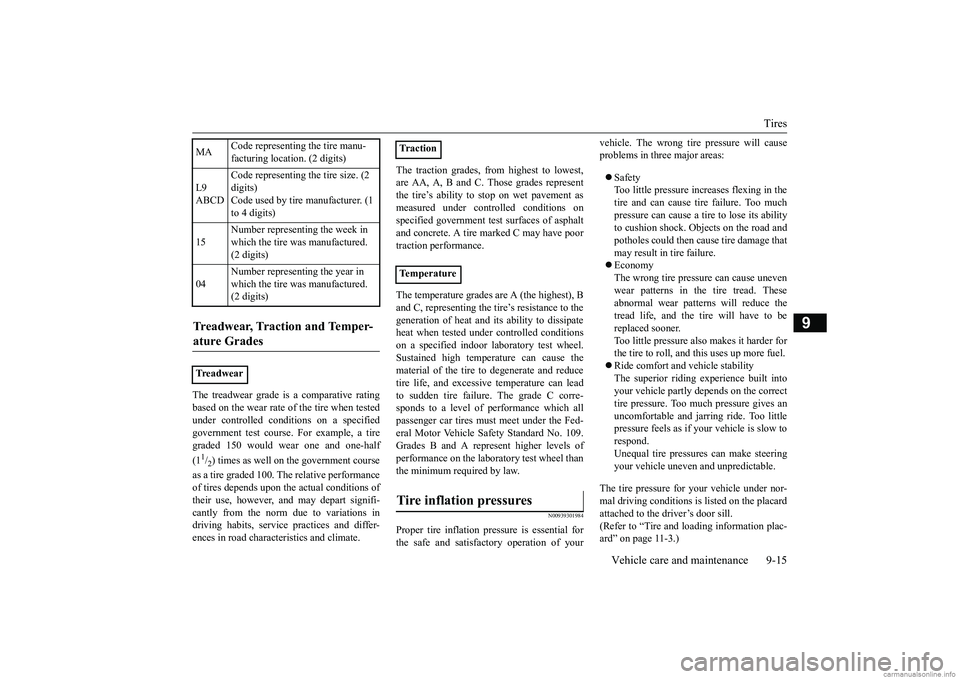
Tires
Vehicle care and maintenance 9-15
9
The treadwear grade is a comparative rating based on the wear rate of the tire when tested under controlled conditions on a specifiedgovernment test course. For example, a tire graded 150 would wear one and one-half (11/2) times as well on th
e government course
as a tire graded 100. The relative performance of tires depends upon th
e actual conditions of
their use, however, and may depart signifi- cantly from the norm due to variations in driving habits, service
practices and differ-
ences in road characteristics and climate.
The traction grades, from highest to lowest, are AA, A, B and C. Those grades representthe tire’s ability to stop on wet pavement as measured under contro
lled conditions on
specified government te
st surfaces of asphalt
and concrete. A tire
marked C may have poor
traction performance. The temperature grades
are A (the highest), B
and C, representing the tire’s resistance to the generation of heat and
its ability to dissipate
heat when tested under controlled conditionson a specified indoor laboratory test wheel. Sustained high temperature can cause the material of the tire to
degenerate and reduce
tire life, and excessive temperature can lead to sudden tire failure. The grade C corre- sponds to a level of performance which allpassenger car tires must meet under the Fed- eral Motor Vehicle Safety Standard No. 109. Grades B and A represent higher levels ofperformance on the laboratory test wheel than the minimum required by law.
N00939301984
Proper tire inflation pressure is essential forthe safe and satisfactory operation of your
vehicle. The wrong tire pressure will cause problems in three major areas: Safety Too little pressure increases flexing in the tire and can cause tire failure. Too much pressure can cause a tire to lose its abilityto cushion shock. Objects on the road and potholes could then ca
use tire damage that
may result in tire failure. Economy The wrong tire pressu
re can cause uneven
wear patterns in the tire tread. These abnormal wear patter
ns will reduce the
tread life, and the tire will have to bereplaced sooner. Too little pressure also makes it harder for the tire to roll, and this uses up more fuel. Ride comfort and vehicle stability The superior riding experience built into your vehicle partly de
pends on the correct
tire pressure. Too much pressure gives an uncomfortable and jarring ride. Too little pressure feels as if
your vehicle is slow to
respond. Unequal tire pressure
s can make steering
your vehicle uneven
and unpredictable.
The tire pressure for your vehicle under nor- mal driving conditions is listed on the placard attached to the driver’s door sill. (Refer to “Tire and loading information plac-ard” on page 11-3.)
MA
Code representing the tire manu- facturing location. (2 digits)
L9 ABCD
Code representing the tire size. (2 digits) Code used by tire manufacturer. (1 to 4 digits)
15
Number representing the week in which the tire was manufactured. (2 digits)
04
Number representing the year in which the tire was manufactured. (2 digits)
Treadwear, Traction and Temper- ature Grades Treadwear
Tr a c t i o n TemperatureTire inflation pressures
BK0267800US.book 15 ページ 2018年5月30日 水曜日 午後4時24分
Page 227 of 267
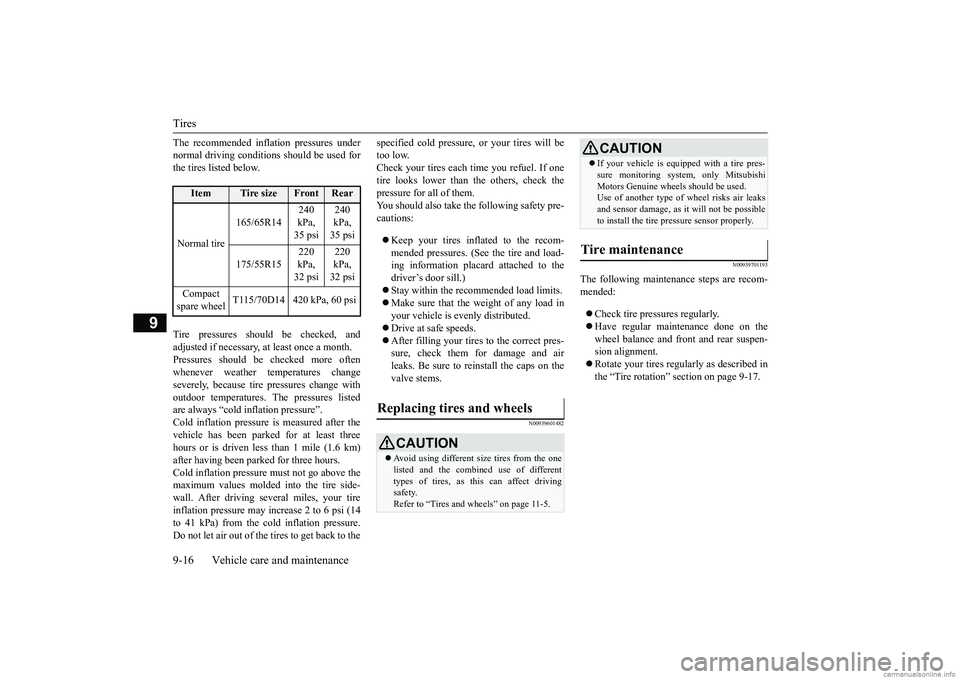
Tires 9-16 Vehicle care and maintenance
9
The recommended inflation pressures under normal driving conditions should be used forthe tires listed below. Tire pressures should be checked, and adjusted if necessary, at least once a month. Pressures should be checked more often whenever weather temperatures changeseverely, becaus
e tire pressures change with
outdoor temperatures. The pressures listed are always “cold inflation pressure”.Cold inflation pressure is measured after the vehicle has been parked
for at least three
hours or is driven less than 1 mile (1.6 km)after having been parked for three hours. Cold inflation pressure must not go above the maximum values molded into the tire side-wall. After driving seve
ral miles, your tire
inflation pressure may increase 2 to 6 psi (14 to 41 kPa) from the cold inflation pressure.Do not let air out of the tires to get back to the
specified cold pressure, or your tires will be too low.Check your tires each time you refuel. If one tire looks lower than the others, check the pressure for all of them.You should also take the following safety pre- cautions: Keep your tires inflated to the recom- mended pressures. (See the tire and load-ing information placard attached to the driver’s door sill.) Stay within the recommended load limits. Make sure that the weight of any load in your vehicle is evenly distributed. Drive at safe speeds. After filling your tires to the correct pres- sure, check them for damage and airleaks. Be sure to reinstall the caps on the valve stems.
N00939601482
N00939701193
The following maintenance steps are recom- mended: Check tire pressures regularly. Have regular maintenance done on the wheel balance and front and rear suspen-sion alignment. Rotate your tires regularly as described in the “Tire rotation” section on page 9-17.
Item
Tire size
Front
Rear
Normal tire
165/65R14
240 kPa, 35 psi
240 kPa, 35 psi
175/55R15
220 kPa, 32 psi
220 kPa, 32 psi
Compact spare wheel
T115/70D14 420 kPa, 60 psi
Replacing tires and wheels
CAUTION Avoid using different size tires from the one listed and the combined use of different types of tires, as this can affect driving safety.Refer to “Tires and wheels” on page 11-5.
If your vehicle is equippe
d with a tire pres-
sure monitoring system, only MitsubishiMotors Genuine wheels should be used.Use of another type of
wheel risks air leaks
and sensor damage, as
it will not be possible
to install the tire pressure sensor properly.
Tire maintenance
CAUTION
BK0267800US.book 16 ページ 2018年5月30日 水曜日 午後4時24分
Page 228 of 267
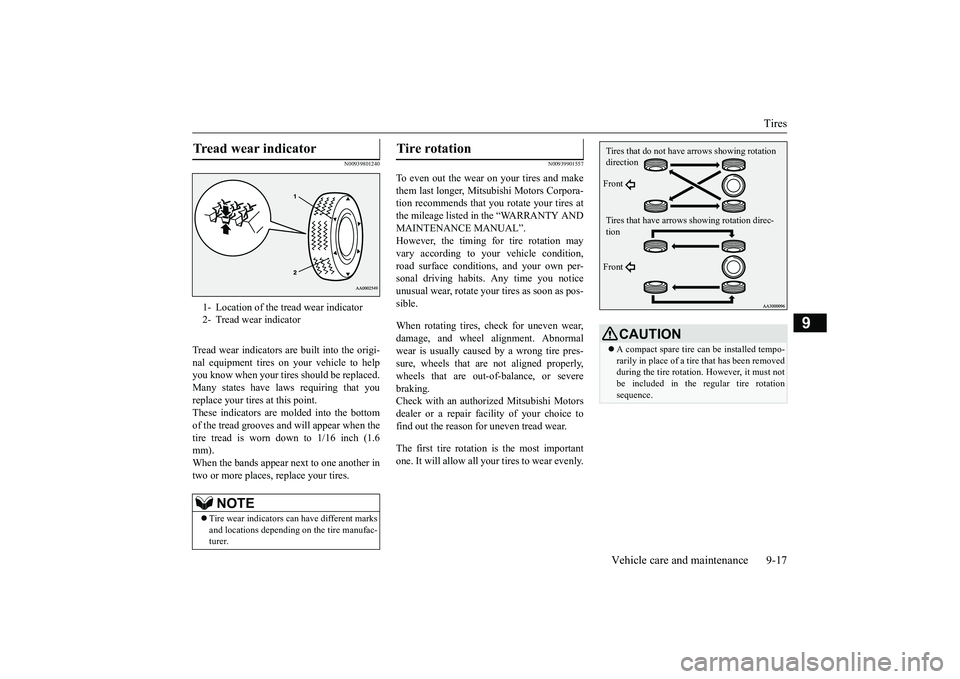
Tires
Vehicle care and maintenance 9-17
9
N00939801240
Tread wear indicators ar
e built into the origi-
nal equipment tires on
your vehicle to help
you know when your tires should be replaced. Many states have la
ws requiring that you
replace your tires at this point.These indicators are molded into the bottom of the tread grooves and will appear when the tire tread is worn down to 1/16 inch (1.6mm). When the bands appear next to one another in two or more places
, replace your tires.
N00939901557
To even out the wear on your tires and make them last longer, Mitsubishi Motors Corpora- tion recommends that y
ou rotate your tires at
the mileage listed in the “WARRANTY AND MAINTENANCE MANUAL”. However, the timing for tire rotation mayvary according to your vehicle condition, road surface conditions, and your own per- sonal driving habits. Any time you notice unusual wear, rotate your
tires as soon as pos-
sible. When rotating tires, check for uneven wear, damage, and wheel al
ignment. Abnormal
wear is usually caused by a wrong tire pres- sure, wheels that ar
e not aligned properly,
wheels that are out-of-balance, or severe braking. Check with an authoriz
ed Mitsubishi Motors
dealer or a repair facility of your choice to find out the reason for uneven tread wear. The first tire rotation is the most important one. It will allow all your tires to wear evenly.
Tread wear indicator 1- Location of the tread wear indicator2- Tread wear indicator
NOTE
Tire wear indicators ca
n have different marks
and locations dependi
ng on the tire manufac-
turer.
Tire rotation
CAUTION A compact spare tire can be installed tempo- rarily in place of a tir
e that has been removed
during the tire rotation. However, it must notbe included in the regular tire rotation sequence.Tires that do not have arrows showing rotation direction Front Tires that have arrows
showing rotation direc-
tion Front
BK0267800US.book 17 ページ 2018年5月30日 水曜日 午後4時24分
Page 229 of 267
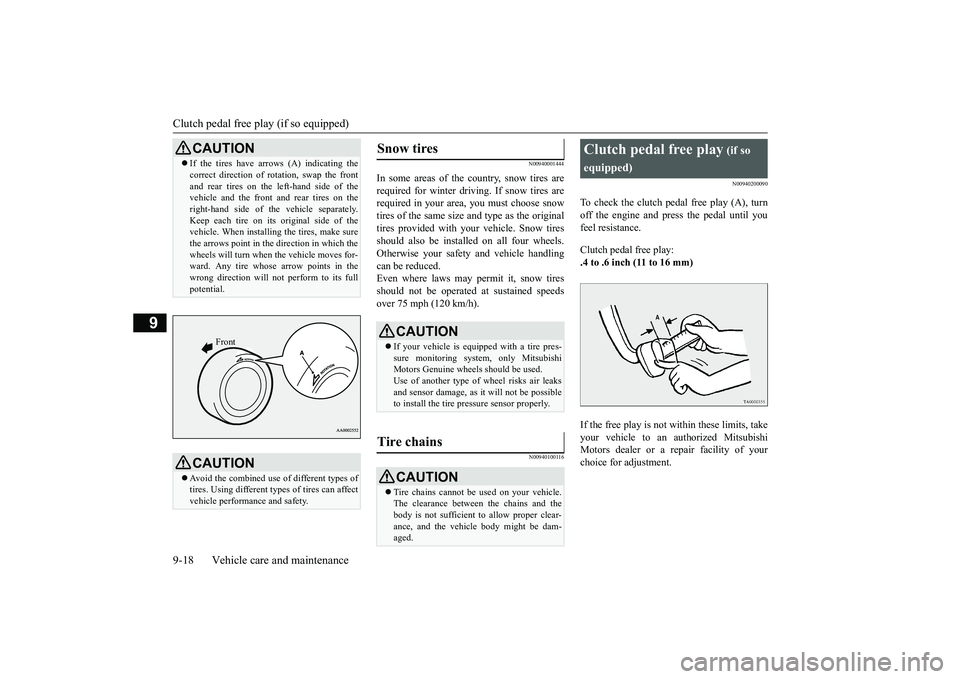
Clutch pedal free play (if so equipped) 9-18 Vehicle care and maintenance
9
N00940001444
In some areas of the country, snow tires are required for winter driv
ing. If snow tires are
required in your area, you must choose snowtires of the same size
and type as the original
tires provided with your
vehicle. Snow tires
should also be installe
d on all four wheels.
Otherwise your safety
and vehicle handling
can be reduced. Even where laws may permit it, snow tires should not be operated
at sustained speeds
over 75 mph (120 km/h).
N00940100116
N00940200090
To check the clutch pedal free play (A), turn off the engine and press the pedal until youfeel resistance. Clutch pedal free play: .4 to .6 inch (11 to 16 mm) If the free play is not within these limits, take your vehicle to an authorized Mitsubishi Motors dealer or a repair facility of yourchoice for adjustment.
CAUTION If the tires have arrows (A) indicating the correct direction of rotation, swap the frontand rear tires on the left-hand side of thevehicle and the front and rear tires on the right-hand side of th
e vehicle separately.
Keep each tire on its original side of thevehicle. When installi
ng the tires, make sure
the arrows point in the direction in which the wheels will turn when the vehicle moves for-ward. Any tire whose
arrow points in the
wrong direction will not
perform to its full
potential.CAUTION Avoid the combined use of different types of tires. Using different t
ypes of tires can affect
vehicle performance and safety.
Front
Snow tires
CAUTION If your vehicle is equipped with a tire pres- sure monitoring system, only Mitsubishi Motors Genuine whee
ls should be used.
Use of another type of wheel risks air leaks and sensor damage, as it
will not be possible
to install the tire pressure sensor properly.
Tire chains
CAUTION Tire chains cannot be used on your vehicle. The clearance between
the chains and the
body is not sufficient
to allow proper clear-
ance, and the vehicle body might be dam- aged.
Clutch pedal free play
(if so
equipped)
BK0267800US.book 18 ページ 2018年5月30日 水曜日 午後4時24分
Page 230 of 267
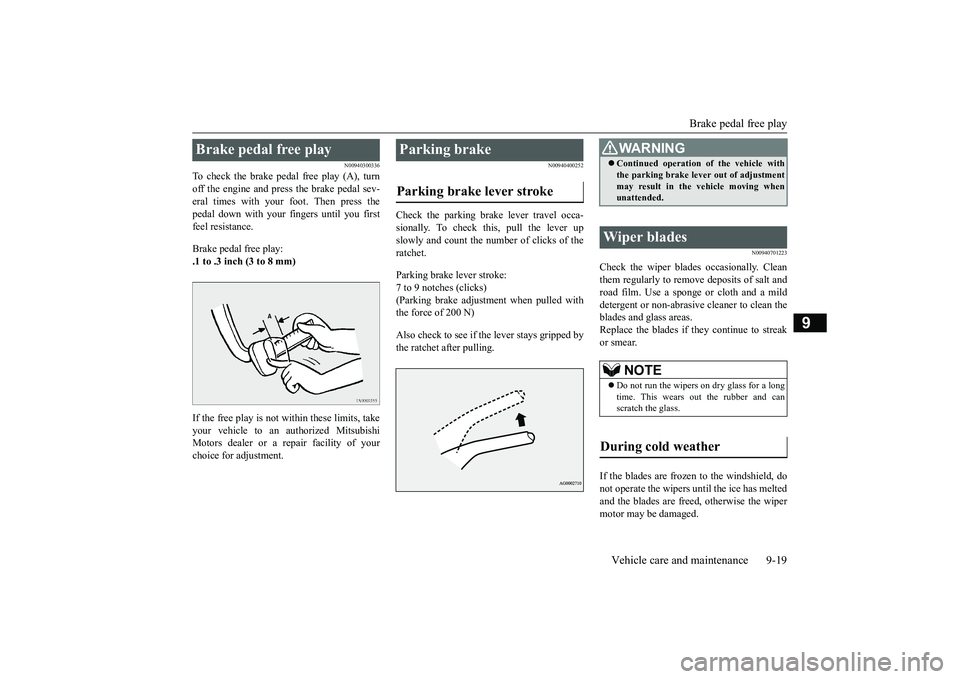
Brake pedal free play
Vehicle care and maintenance 9-19
9
N00940300336
To check the brake pedal free play (A), turn off the engine and press the brake pedal sev- eral times with your
foot. Then press the
pedal down with your fingers until you first feel resistance. Brake pedal free play: .1 to .3 inch (3 to 8 mm) If the free play is not within these limits, take your vehicle to an authorized Mitsubishi Motors dealer or a repair facility of yourchoice for adjustment.
N00940400252
Check the parking brake lever travel occa-sionally. To check this, pull the lever up slowly and count the number of clicks of the ratchet. Parking brake lever stroke: 7 to 9 notches (clicks) (Parking brake adjustme
nt when pulled with
the force of 200 N) Also check to see if the lever stays gripped by the ratchet after pulling.
N00940701223
Check the wiper blades occasionally. Clean them regularly to rem
ove deposits of salt and
road film. Use a sponge or cloth and a mild detergent or non-abrasive cleaner to clean theblades and glass areas. Replace the blades if they continue to streak or smear. If the blades are frozen to the windshield, do not operate the wipers
until the ice has melted
and the blades are free
d, otherwise the wiper
motor may be damaged.
Brake pedal free play
Parking brake Parking brake lever stroke
WA R N I N G Continued operation
of the vehicle with
the parking brake leve
r out of adjustment
may result in the vehicle moving whenunattended.
Wiper blades
NOTE
Do not run the wipers on dry glass for a long time. This wears out the rubber and can scratch the glass.
During cold weather
BK0267800US.book 19 ページ 2018年5月30日 水曜日 午後4時24分